The 1990s was a period of rapid development and expansion for picture tubes in China. China successively introduced several picture tube glass shell production lines from companies such as Asahi Glass Co., Ltd. (Japan), Nippon Electric Glass Co., Ltd. (Japan), Corning Inc. (USA), and Italy, forming a substantial production capacity for picture tube glass shells. Glass shells are primarily used for display screens and television screens. Various types of picture tubes are generally composed of glass shells, which maintain a high vacuum inside. In the production process of color picture tube glass shells, the molten glass from the melting glass furnace enters the working end through the throat, where the glass shell screen is formed.
The picture tube glass furnace is one of the key thermal equipment in the glass shell production process. The design, material selection, construction, operation, and maintenance of glass furnaces are all centered around ensuring the quality of the molten glass and glass products, intensifying production to increase melting efficiency, saving energy consumption, and extending glass furnace life, ultimately achieving the best comprehensive economic benefits over the entire campaign. Therefore, improving glass furnace life and saving energy consumption are of great significance for achieving the optimal economic benefits of the entire campaign. The melting rate, glass composition, and temperature of the glass furnace play a decisive role in the quality, quantity, and yield of picture tube glass shells. To increase the melting rate and implement intensive melting, the melting temperature must be raised (generally the melting temperature is 1570°C–1580°C). Practice has proven that high-temperature intensive melting is an important way to increase the output of the tank glass furnace, improve glass quality, and reduce specific heat consumption.
2 Functions of the Regenerator Chimney
3. Development of Refractory Materials for Regenerator Chimney
4. Rational Configuration of Refractory Materials for Glass furnace Regenerator Chimney
5. Fused Cast Refractories for the Regenerator Chimney of Picture Tube Glass furnaces
6. Technical Approaches to Improve the Service Performance of Fused Cast AZS Chimney Bricks
The regenerator is one of the key parts of a glass furnace. It not only plays an important role in the melting end, glass quality, and energy saving of the glass furnace, but the condition of the regenerator also directly affects the lifespan of the entire glass furnace. Especially the chimney of the regenerator, its service life is one of the key factors determining whether the entire glass furnace can reach its design life.
The exhaust gas leaving the flame space of the glass furnace is at a very high temperature (up to 1500°C) and carries away a large amount of thermal energy, generally accounting for about 70% of the heat supplied to the glass furnace. The function of the regenerator is to transfer the heat from the exhaust gas to the combustion air or gas through the heat storage action of the chimney. As the preheating temperature of the combustion air increases, the efficiency and economic benefits of the glass furnace also improve accordingly. Modern high-efficiency glass furnaces, from an energy-saving perspective, recover about 40% of the total recovered heat in the regenerator, an amount equivalent to the sum of the heat recovered from the crown, sidewalls, and bottom.
The working environment of the regenerator chimney during operation is very harsh, with many adverse factors such as: chemical erosion from exhaust gases, dust particles in the exhaust gas, and condensed glassy substances; high-temperature effects; thermal stress caused by temperature fluctuations; and mechanical stress caused by the self-weight of the chimney. These adverse factors threaten the service life of the chimney and are also extremely detrimental to the entire glass furnace and glass production. Because the harsh operating environment accelerates the aging process of the regenerator chimney, causing blockage, creep, or collapse of the chimney, increasing maintenance costs, causing a rapid decline in thermal efficiency, increasing energy consumption, leading to decreased glass quality, production difficulties, and accelerated glass furnace erosion. In severe cases, it may necessitate cold repair of the glass furnace by draining the glass ahead of schedule. Therefore, the structure, material selection, quality, rational matching of the regenerator chimney, and necessary maintenance measures for the regenerator are extremely important for reducing or eliminating the effects of the aforementioned adverse factors and improving thermal efficiency.
Fused cast refractories have excellent resistance to alkali erosion and are less prone to blockage; they have a high volumetric specific heat and strong heat storage capacity; especially when using thin-walled fused cast AZS tubular bricks or fused cast cross-shaped bricks, they are easy to stack and have good stability. Even though the investment cost for fused cast AZS refractories is more than double that of traditional basic materials, they can save energy and stabilize the glass furnace operating system, and the additional cost can be recovered within 2–3 years. Therefore, currently, most domestically introduced picture tube glass furnace regenerators basically use fused cast AZS refractories for the chimney.
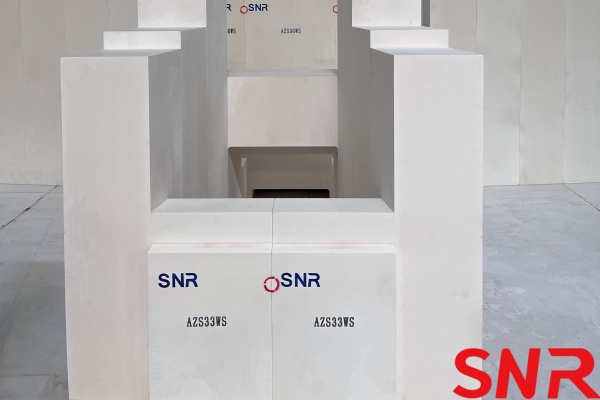
2. Functions of the Regenerator Chimney
In float glass or electronic tube glass furnaces, the main body of the glass furnace regenerator is the chimney composed of checker bricks. Its main function is to recover the heat from the glass furnace combustion flue gas and preheat the secondary combustion air, achieving the purpose of heat recovery. The air preheat temperature is usually used to indicate the heat recovery rate of the regenerator. Data shows that when the preheat temperature increases by 200–300 °C, fuel can be saved by 10%–15%.
The regenerator chimney is one of the key parts of the glass furnace. It must not only improve thermal efficiency, ensure stable temperature and pressure regimes in the glass furnace, and meet the requirements for glass output and quality, but also have a sufficiently long service life. The refractory materials in the regenerator have different usage conditions depending on the location, as shown in Table 1.
|
Table 1 Usage Conditions in Different Parts of the Regenerator |
|||
|
Position |
Temperature Range |
Reaction Type |
Erosion Medium |
|
Top |
Above 1400°C |
Solid-Solid |
High-temperature Fly Ash |
|
Upper Part |
1100~1300°C |
Gas-Solid |
Alkali Vapor |
|
Middle Part |
800~1000°C |
Liquid-Gas-Solid |
Sulfate Condensation |
|
Lower Part |
Below 800°C |
Liquid-Solid |
Fly Ash and Alkali |
3. Development of Refractory Materials for Regenerator Chimney
Abroad, since the early 1950s, basic refractories have been selected for building the chimney of glass furnace regenerators. Because the basic components reacted with the previously widely used Al2O3-SiO2 series refractories to form nepheline, causing significant volume expansion leading to the cracking of the chimney. After switching to magnesia bricks for construction, although there was indeed no nepheline reaction, the periclase recrystallized and grew, MgO reacted with SO3 to form MgSO4, and the occurrence of silicate bursting phenomena also prevented magnesia bricks from becoming an ideal material.
By the 1960s, heavy oil fuel became increasingly popular, relatively increasing impurities such as S, Ni, V, especially SO3 and Na2SO4, which destroyed magnesia bricks in the temperature range of 700°C – 1100°C, so magnesia-chrome bricks and forsterite bricks were adopted. This is what is referred to as the second generation of basic chimney. However, M2S (magnesium silicate) has relatively poor thermal shock resistance and is prone to spalling. Adding an appropriate amount of MA (magnesium aluminate spinel) can improve thermal shock resistance. This was the earliest indication that MA is beneficial for chimney operating conditions. The development of the third generation of basic bricks began in the late 1960s with the application of high-purity magnesia bricks. To improve the high-temperature mechanical properties of magnesia bricks, the bonding phase was controlled to be C2S (dicalcium silicate). But this was also one-sided, as it ignored the strong erosion effect of V and S from the chimney dust on C2S while unilaterally considering the contribution of C2S to the material‘s high-temperature mechanical properties. At the same time, when C2S -bonded magnesia bricks were used in the upper part of the chimney, reacting with components in the dust to form CMS (calcium magnesium silicate) or C2MS3 (calcium magnesium silicate), it caused a relatively large volume expansion, similarly reducing the bonding strength.
However, for special glass furnaces such as those for picture tube glass, lead glass, borosilicate glass, etc., using basic refractories to build the chimney is also not suitable. Starting in 1971, the French company SEPR produced cross-shaped fused cast AZS products with the brand name ER1690P, which were used in special glass furnaces with quite good results. Of course, the surface of the bricks in the upper part of the chimney still had the issue of nephelinization caused by Na erosion, but this could be improved by adding other components. Fused cast AZS cross-shaped products are a parallel series product to basic materials. Due to their high cost, they are limited to use in special glass furnaces.
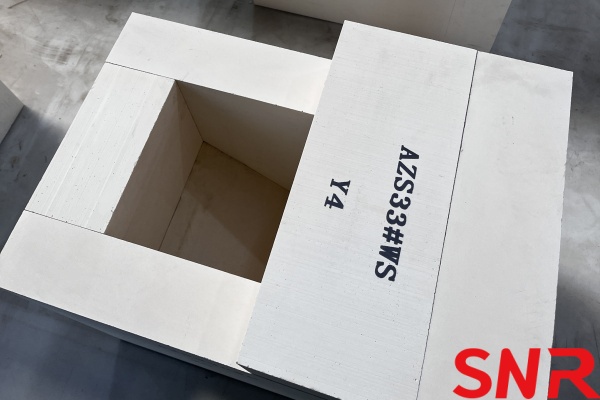
4. Rational Configuration of Refractory Materials for Glass furnace Regenerator Chimney
Because the operating environment and erosion conditions differ from top to bottom in the glass furnace regenerator chimney, it is necessary to carefully select and rationally configure the refractory materials so that the degree of loss of the refractory materials in the upper and lower parts is similar within the same usage cycle, achieving the expected balanced service life, being technically reliable and economically reasonable.
The material selection for the regenerator chimney is divided into two series: one is the set of basic refractory materials commonly used in many European countries, and the other is the cross-shaped fused cast refractory materials.
4.1 Basic Refractory Materials
Currently, domestic float glass furnace regenerators generally use basic materials for the chimney. Because the upper checker bricks are at the highest temperature and suffer the most severe erosion, directly bonded high-purity magnesia bricks (DMZ) with an MgO content requirement of 98% are selected. These bricks use high-purity magnesia, are high-pressure formed, form a sintered direct bond at high temperatures, have little glass phase in the brick, good creep resistance, low porosity, and are particularly resistant to alkali erosion. The top of the regenerator checker bricks is near the doghouse, which is an area where fine SiO2 powder from the batch is easily blown in. The top basic checker bricks react with acidic SiO2, generating silicates, which have a dense structure, poor thermal shock resistance, and are prone to "silicate bursting". Therefore, the top layer can be lined with 2-3 layers of mullite bricks.
Although the temperature in the middle layer of checker bricks is lower than the upper layer, it is the most prone to problems. The reasons are: erosion by Na2SO4, and volume changes caused by transformations between gas-liquid-solid leading to brick damage; SO4 in the flue gas reacts with periclase to form MgSO4, making the brick structure brittle and causing pulverization; sufficient load-bearing strength is required at medium-high temperatures; phenomena such as sticking and build-up are prone to occur. Therefore, the middle layer is a key part, and material selection is the most difficult. Currently, in China, magnesia-chrome bricks are mostly used in the middle layer. Magnesia-chrome bricks have relatively good resistance to the above erosion effects. These bricks have small porosity, good penetration resistance, good thermal shock resistance, and good creep resistance. However, these bricks easily form hexavalent chromium under the action of calcium and magnesium oxides, polluting the environment.
Forsterite bricks are also sometimes selected for the middle layer checker bricks. According to feedback from some glass shell factories, these bricks are prone to bursting. The reason is that Fe2O3 in the brick is reduced to FeO under a reducing atmosphere, causing volume expansion, and the thermal shock resistance is not very good either. Currently, some glass shell factories have introduced magnesia-zirconia bricks (containing MgO 75%, ZrO2 13.5%), which have shown good results in use.
The temperature in the lower layer checker bricks is below 800°C, but they are still subject to erosion by Na2SO4, as well as thermal shocks during hot repairs. The brick material is required not to react with basic bricks and to have sufficient medium-temperature strength. Generally, low-porosity fireclay bricks are selected. These bricks have low porosity, resistance to spalling, high compressive strength, good thermal shock stability, and can meet the requirements of the operating environment.
4.2 Cross-shaped Fused Cast Refractory Materials
The main advantages of selecting cross-shaped fused cast checker bricks are:
1) The thickness of ordinary checker bricks is 65mm, while the thickness of cross-shaped checker bricks is reduced to 40mm, resulting in high heat recovery rate and increased preheating temperature of the combustion air.
2) Compared with basic checker bricks, cross-shaped checker bricks reduce weight by more than 20% and have stable structure.
3) Cross-shaped checker bricks manufactured by special casting methods have a dense surface without concentrated shrinkage cavities, but rather dispersed micropores, avoiding damage caused by volume changes due to ZrO2 crystal transformation around 1100°C, and have relatively good thermal shock resistance. Under actual operating conditions with repeated temperature changes, compared with basic bricks, they can maintain clear checker passages for a long time.
4) Cross-shaped checker bricks have high thermal conductivity, large heat capacity, and a relatively large comprehensive heat transfer coefficient. Compared with basic bricks, they have a larger heat exchange area and higher heat recovery rate.
5) As the operating time of cross-shaped checker bricks extends, the changes in structural strength and energy consumption are small, enabling energy savings of 10%~20%, and the service life can reach 8-10 years.
When using imported fused cast bricks to build the chimney, it is recommended to select β-alumina bricks containing MgO for the upper part, and use fused cast AZS blocks further down. This is because the Al2O3 and glass matrix in fused cast AZS blocks react with alkali, generating nepheline and α-Al2O3 accompanied by volume changes, forming cracks, which can lead to chimney damage. Using β-alumina bricks containing MgO improves the resistance to alkali erosion.
Although the investment cost for cross-shaped checker bricks is more than double that of traditional ones, they can save energy and stabilize the glass furnace operating system, and the additional cost can be recovered within 2-3 years.
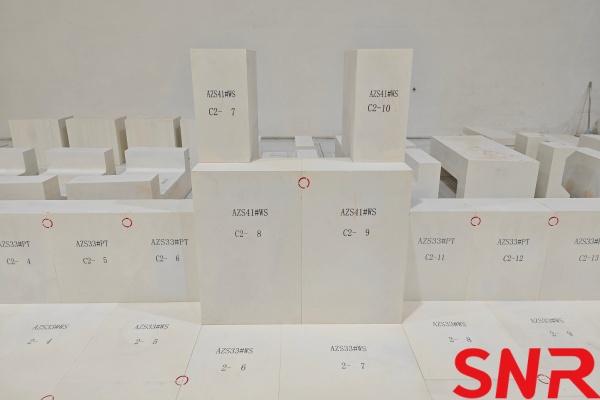
5. Fused Cast Refractories for the Regenerator Chimney of Picture Tube Glass furnaces
5.1 Fused Cast Refractories
The earliest domestic manufacturers of fused cast AZS products were Shenyang Refractory Material Factory and Shanghai Renmin Refractory Factory. Before the 1980s, only reduction process products of the ZrO2-33 grade could be produced. After the 1980s, production rapidly became widespread, and fused cast AZS product production lines were established in Luoyang, Zhengzhou, Shandong, Beijing, and other places. Especially in recent years, many manufacturers have cooperated with foreign companies, introducing technology from France, the United States, and Japan, launching corresponding brands, bringing the quality of domestic products close to or reaching the level of famous foreign brand products.
The production process of fused cast AZS products includes two main processes: melting and casting. The melting process requires complete and uniform melting of the raw materials, adjusting the power regime and carbon electrode position to achieve the lowest carbon and gas content in the melt, thereby increasing the liquid phase exudation temperature and reducing the exudation amount. The casting process requires achieving accurate external dimensions, full casting, controlling the volume and position of shrinkage cavities, and preventing annealing cracks. These two processes complement each other. Each grade of product is further divided into four types based on the casting process: Regular Casting (RC), Dense Casting (DC), Tilt Casting (TC), and Void-Free Casting (VF). Products produced by different casting methods have different shrinkage cavity volumes and positions, and their microstructures also differ somewhat. Fused cast AZS products can be divided into two categories: reduction melting method and oxidation melting method. Currently, the reduction process has been phased out.
The raw materials for fused cast AZS blocks are chemically treated industrial alumina powder and selected high-purity zircon sand (ZrO2·SiO2), with small amounts of additives such as sodium oxide, boron oxide, and rare earth oxides added. The composed batch is melted in an electric arc glass furnace, cast into molds, and slowly cooled to produce the refractory material.
The mineral composition includes corundum, baddeleyite, and glass phase. Baddeleyite microcrystals act as the matrix phase, forming a network filling between baddeleyite, corundum, and the glass phase. The glass phase is generally around 20%. The main crystal phases of the conventional ZrO2-33, 36, and 41 grade products are all ZrO2-corundum eutectic (C+Z). Due to the addition of 1-1.5% Na2O in the batch, a certain amount of glass phase is formed, which is the main reason for inhibiting mullite crystallization. Normally, mullite does not exist in the standard products. If mullite appears, it is the product of peritectic reaction by corundum resorption or secondary crystallization from the liquid phase.
Currently, fused cast refractories are widely used in high-wear areas of glass furnaces, including fused cast AZS blocks, fused cast alumina series (such as fused cast α-alumina bricks, fused cast β-alumina bricks, fused cast α-β alumina bricks), etc. Among them, fused cast AZS blocks have excellent erosion resistance and are widely used in contact areas with molten glass in the glass tank, glass furnace crowns for glass fiber, and regenerator checker bricks.
5.2 Fused Cast Checker Bricks for the Regenerator of Picture Tube Glass furnaces
Since the 1960s, fused cast products began to be used internationally for regenerator chimney, and long-life glass furnaces emerged successively. The use of cross-shaped fused AZS checker bricks has played a significant role in improving glass quality, achieving optimal cost benefits, maintaining stable production, and extending glass furnace service life. Although the investment cost for cross-shaped checker bricks is more than double that of traditional ones, they can save energy and stabilize the glass furnace operating system, and the additional cost can be recovered within 2-3 years. Therefore, currently, most domestically introduced picture tube glass furnace regenerators basically use fused cast checker bricks.
To improve the utilization factor of the regenerator, increase the heat exchange area, and intensify heat exchange, it is necessary to reduce the thickness of the checker bricks. This requires the checker bricks to have sufficient mechanical strength. Fused cast zirconia-based series materials have high mechanical strength, especially fused cast AZS blocks, which far surpass fireclay bricks, magnesia bricks, and magnesia-chrome bricks in this regard. They can be used to manufacture cross-shaped checker bricks with the highest utilization rate and a thickness of 40mm.
5.3 Several Factors Affecting the Erosion Resistance of Fused Cast AZS Checker Bricks
Starting from the erosion mechanism of fused cast AZS checker bricks against CRT glass batch (50% chimney dust + 50% CRT cullet), several factors affecting the resistance of fused cast AZS checker bricks used in the regenerator of picture tube glass furnaces to erosion by CRT glass batch are discussed. This aims to provide some scientific basis for the correct use of fused cast refractories in picture tube glass shell factories.
5.3.1 Influence of Silicon Dioxide (SiO₂) Content
Fused cast AZS checker bricks are mainly composed of AZ eutectoid (corundum-baddeleyite eutectic), finely dispersed baddeleyite, corundum phase, and glass phase. SiO₂, along with trace amounts of B₂O₃, FeO, Fe₂O₃, TiO, TiO₂, ZrO₂, Al₂O₃, CaO, MgO, Na₂O, K₂O, etc., forms the glass phase, which fills the spaces between the various crystalline phases.
If the SiO₂ content is too high, the glass phase will also be excessive. At high temperatures, effects such as the volume change associated with the ZrO₂ monoclinic to tetragonal phase transformation, carbon oxidation effects, and pore expansion effects cause the glass phase to be extruded. The exudation of large amounts of glass phase will carry out finely dispersed baddeleyite and underdeveloped corundum phases, thereby destroying the network skeleton structure formed between the crystalline phases and accelerating the corrosion rate of the product.
If the SiO₂ content is too low, the glass phase in the product is insufficient, which is unfavorable for buffering phase transformation stress, making the product prone to cracking. During use, dust from the regenerator chimney infiltrates along the crack gaps, increasing the erosion area of the product and accelerating the erosion rate.
Therefore, for fused cast AZS products, it is required to reduce the SiO₂ content as much as possible without causing cracking, in order to improve the erosion resistance of the product.
5.3.2 Influence of Carbon Content
During the production of fused cast AZS products, a certain amount of carbon inevitably infiltrates from the electrodes, and a portion ultimately remains in the material. Carbon exists in the forms of C, CO, and CO₂. From the reaction equations 2C + O₂ → 2CO and 2CO + O₂ → 2CO₂, it can be seen that the chimney dust mixed with CRT glass melt contains many oxidizing components, providing sufficient oxygen molecules for the carbon. From the above reactions, it is known that:
After 1 mole of carbon is oxidized, it forms 1 mole of CO₂ gas, and 1 mole of CO₂ gas occupies 22.4L under standard conditions. Generally, the temperature in a glass furnace regenerator is as high as 1480°C. According to V/V₀ = T/T₀, then V = V₀(273 + 1480)/273 = 144L. That is, the oxidation of 1 mole of carbon will produce 144L of CO₂ gas. Furthermore, this reaction is exothermic and can further increase the surrounding temperature. This gas volume expansion process accelerates the exudation of the glass phase, promotes rapid exchange between the glass phase components and the alkaline dust components in the regenerator, further dissolves into the crystal structure of the refractory material, and ultimately causes rapid erosion of the material. This phenomenon has been recognized by both refractory manufacturers and glass shell factories.
To reduce the carbon content in fused cast AZS, refractory manufacturers adopt an oxidizing electric melting process, using long arc melting and oxygen blowing in the liquid state to oxidize the carbon as much as possible. The carbon content in the final product is only between 0.001% and 0.005%.
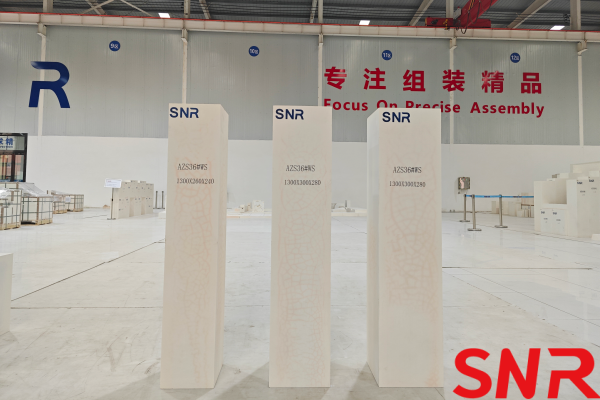
5.3.3 Influence of Impurity Content and Valence State
Another main reason affecting the erosion resistance of fused cast AZS checker bricks is impurities, such as Fe²⁺, Fe³⁺, Ti⁴⁺, Ti²⁺, Ca²⁺, and Mg²⁺. They exist within the glass phase and form low-melting eutectics with SiO₂. The higher their content, the lower the viscosity of the glass phase at high temperatures and the lower the exudation temperature, severely affecting the material‘s erosion resistance. The primary source of these impurities is the raw materials. Refractory production plants must strictly control the raw materials during the production process, rigorously inspect the main incoming raw materials, requiring the iron and titanium content in zircon sand to be less than 0.25%, and the Al₂O₃ content in alumina to be greater than 98.5%.
The valence state of impurities is also an important factor affecting the exudation temperature of the glass phase in the product. Products produced by the reduction method have impurities in a low valence state, while those produced by the oxidation method have impurities in a high valence state. The eutectic point of low-melting eutectics formed by low-valence impurities is much lower than that formed by high-valence impurities.
5.3.4 Influence of Microstructure
Generally, if fused cast AZS products have a high amount of AZ eutectoid, which is well-developed and distributed in elongated or plate-like forms, interweaving to form a skeletal network, with the glass phase uniformly filling the interstices, and if the baddeleyite in the glass phase is uniformly distributed in a bead-like string pattern, then the material exhibits better erosion resistance.
5.3.5 Influence of Closed Pores
Closed pores, i.e., dispersed pores, in fused cast AZS products also affect their erosion resistance. On one hand, the gases enclosed within the pores expand 6.5 times in volume at 1480°C, creating high pressure. As mentioned before, this accelerates the exudation of the glass phase. More importantly, the presence of pores increases the contact area with the glass melt, undoubtedly accelerating the erosion rate. Therefore, refractory manufacturers are committed to producing high-density products.
However, not all parts of fused cast AZS blocks require low porosity. For example, regenerator checker bricks require a relatively high porosity for better thermal shock resistance.
6. Technical Approaches to Improve the Service Performance of Fused Cast AZS Checker Bricks
6.1 Control Raw Material Quality and Select the Optimal Batching Point
Fused cast AZS bricks are designed based on the Al2O3−ZrO2−SiO2 ternary phase diagram. The optimal formula design is the key to forming an ideal crystal phase structure (i.e., a high amount of well-developed baddeleyite-corundum eutectic, with finely dispersed baddeleyite forming a bead-like structure). The ideal crystal phase structure is key to improving the product‘s thermal stability. Therefore, it is necessary to carefully select raw materials and control the content of harmful impurities to meet the following requirements: zircon sand with ZrO2≥66.5%, Σ impurities <0.9%, Fe2O3+TiO2<0.1%; industrial alumina with Al2O3≥98.6%. Furthermore, to achieve the optimal formula design, measures such as adding desilicated zirconia can be adopted.
6.2 Strengthen Online Quality Control
The chemical composition of fused cast refractories is one of the key factors determining their crystal phase structure and physicochemical properties. Strengthening the control of the batch chemical composition is very important for stabilizing and improving product quality. The "Fused Cast Refractory Quality Control System" developed by the China Building Materials Academy consists of a batching part centered on automatic computer control and a detection part centered on isotope X-ray fluorescence analyzers and atomic absorption spectrometers, achieving interlocked control of automatic batching and rapid detection feedback.
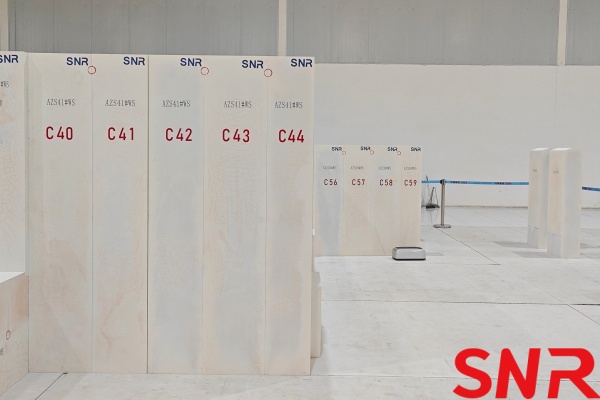
6.3 Improve Melting and Casting Processes
During the melting stage, reasonable melting processes and electrical parameters should be determined based on the properties of the raw materials.
(1) Sufficiently high current and power are required to fully melt the batch;
(2) Reasonable voltage is needed to ensure arc length and arc stability, maximizing the direct oxidation and removal of carbon particles falling from the electrodes within the arc length range;
(3) Comprehensive oxygen blowing measures should be taken to fully oxidize and volatilize the carbon infiltrated through the electrode arc migration, and to ensure Ti, Si, etc., exist in the form of high-valent oxides, so that the final product achieves a high degree of oxidation;
(4) During the casting stage, control the riser and casting angle to achieve the expected product density and shrinkage cavity position.
6.4 Select a Reasonable Annealing Process Regime
The annealing process is a key factor affecting the product process and whether cracks form. In this process, while minimizing cracking and ensuring the yield, it is also necessary to eliminate residual stress to the greatest extent to avoid brick bursting after installation in the glass furnace. Therefore, in the annealing process, besides using copper core materials with excellent annealing performance for complex shapes, different annealing process methods should be formulated according to the different shapes of the products and the principle of uniform heat dissipation to ensure high product quality.
Henan SNR Refractory Co., Ltd. is dedicated to the manufacture, research and development of fused cast AZS refractory blocks and bonded refractory materials for the glass industry. Meanwhile, SNR can provide total solutions and services for glass furnace design, glass furnace construction, renovation, and upgrading. Please contact me if you have any requirements.
CONTACT:
zoe@snrefractory.com/ WhatsApp:+86 15670323812 


